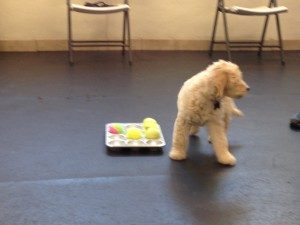RELAXATION / ATTENTION
- Clicking and treating for eye contact
- Teaching go to Mat
- Relaxation on a Mat
INFORMATION
Clicker Basics
- We use a clicker to mark what we like
- We follow each click with a treat
- We ignore what we don’t want
Food Treats
- We use food because it’s a primary reinforcer: it is needed to live, and is inherently rewarding.
- Food is an efficient reward
- We treat generously in terms of rate of reinforcement
Try giving your dog ten treats in ten seconds and see how strong his response is. - We’re stingy with respect to the size of each treat
The size of a tiny pea is plenty for a large dog.
Four Ways to Train a New Behavior
- Lure
Use food to move your dog into position. Click/treat. - Capture
Catch your dog in the act of doing something you like. Click/treat. - Shape
Click/treat approximations of the goal behavior. - Target
Teach your dog to touch nose, paw, or other body part to a target. Use targeting to create more complex behaviors.
BEHAVIOR
Targeting
Teach your dog to touch a body part such as a nose or paw to the target. Some targets might be:
- Hand
Your dog touches his nose or paw to your hand. - Mat
Your dog goes to lie down on his mat. - Crate
Your dog goes into his crate. - Eye contact
When your dog makes eye contact with you even this is a form of targeting: orienting his eyes to your eyes.
From the Levels by Sue Ailsby:
Sue Ailsby is an accomplished trainer in Canada who developed a wonderfully layered approach to training dogs. With her blessing we are using many of her materials as part of our curriculum, with her original Canadian spelling intact. Here is a list of steps she has written to teach and develop targeting behavior. Note what she calls “comeafters”. Those are nice developments of the original behavior which raise the bar ever so slightly.
- Dog touches your hand with her nose.
Add a cue.
Comeafters – Change your position and reteach - Dog reaches high and low to touch your hand with her nose.
Add the cue.
Comeafters – Teach the same behaviour with another person nearby - Dog takes 3 steps to touch your hand.
Add the cue.
Comeafters – Teach the same behaviour in another room
- Dog touches your hand twice to get 1 click.
Add the cue.
Comeafters – Teach all [the previous] Steps with the dog targeting your foot
- Practise moving dog with your hand target
CONFIDENCE / SOCIALIZATION
Exploring Novel Objects
We let our puppies interact with an assortment of weird things at their own pace. Sometimes we’d give them a treat, or a click/treat, for being brave. Some of the objects included:
- Chairs on their sides
- Stools on their sides
- Cones
- Toys
HOMEWORK
Catch your dog doing five things you like. Click and treat!
Things to Bring
- Your Pup!
- Well-behaved children and spouses 8 or older.
- A flat collar, harness, or martingale collar.
- Lots of pea-sized soft treats in at least two different flavors. 200 tiny pieces are not too many. Some suggestions: Hot dogs, String cheese, Meatballs, Chicken or Tuna, Baby food (in a camping tube), Vienna sausages, Liverwurst, Thin-sliced Beef.
- A fanny pack, carpenter’s apron, or treat pouch to hold your 200 tiny pieces.
- A 6-foot leash.
- A mat, bathmat, towel, or blanket for your puppy or dog to rest on.
- Water and a bowl for when your pup gets thirsty.
Do's and Don'ts
- Do let us know if your pup has any food allergies so that we can be careful not to give him a troublesome treat.
- Don’t bring prong, choke, shock, or citronella collars.
- Don’t bring Flexi or other retractable leashes.
- Puppies and dogs should not meet while on leash in class, or while coming and going. There will be opportunities for off-leash play for compatible puppies, and good neighbor exercises for older pups and dogs.
- Don’t feed a heavy meal before coming to class. In fact, your in-class treats can serve as your dog’s breakfast on class day!
- If your puppy or dog is ill, please leave him at home to recuperate, but feel free to come to class without him so that you can learn what’s on the agenda for that day.
Puppy Kindergarten
Puppy Topics
Puppy eBooks
- Ian Dunbar’s Before You Get Your Puppy
- Ian Dunbar’s After You Get Your Puppy
Training Video
Homework 1
- Play with your puppy.
- Catch your pup in the act of doing five different things you like. Click and Treat. Repeat.
Homework 2
- Have your dog “Wait” for you to put her food bowl down for each meal.
- Couple handling with treats a few times a day.
Homework 3
- Practice Loose Leash Walking in a new location. Remember that three good steps are so much better than thirty steps on a tight leash.
- Look for features on your walks that can serve as parts of an Out-and-About Confidence Course.
Homework 4
- Surprise your dog with ten treats in ten seconds at least three times a day.
- Practice the Name Game three times a day.
Homework 5
- Discover a new opportunity to help your dog choose an appropriate behavior.
- Write down the first five steps that you would train.


